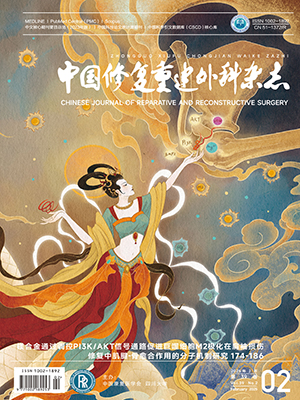【Abstract】 Objective To investigate the operative techniques and cl inical results of repairing the soft tissue defects
of forearm and hand with free peroneal perforator-based sural neurofasciocutaneous flap. Methods From May 2006 to
January 2007, 6 patients including 5 males and 1 female were treated. Their ages ranged from 22 years to 51 years. They were injured by motor vehicle accidents (2 cases), or crushed by machines (4 cases), with skin defect of hand in 1 case, skin defect of hand associated with tendon injuries and metacarpal fractures in 2 cases, skin defect of forearm in 2 cases, and forearm skin defects with fractures of radius and ulna in 1 case. The areas of soft tissue defect ranged from 16 cm × 7 cm to 24 cm × 10 cm. The debridement and the primary treatment to tendons or bones were performed on emergency. And free flaps were transplanted when the wound areas were stable at 4 to 7 days after the emergent treatment. During the operation, the flaps were designed along the axis of the sural nerve nutrient vessels according to the shape and size of the soft tissue defects, with the peroneal perforator above the lateral malleolus as the pedicle and along with a part of the peroneal artery for vascula anastomosis. Then the flaps were harvested and transferred to the reci pient sites with the peroneal vartey anastomosed to the radial (or ulnar) artery and the peroneal veins to one of the radial (or ulnar) veins and the cephal ic vein, respectively. The flap size ranged from 18 cm × 8 cm to 25 cm × 12 cm. The donor areas were closed by skin grafts. Results The 5 flaps survived after the surgery. Partial inadequate venous return and distal superficial necrosis happened in only 1 case, which also got secondary heal ing by changing dressing and anti-infective therapy. The donor sites reached primary heal ing completely. The followed-up in all the patients for 6 to 13 months revealed that the appearance and function of the flaps were all satisfactory, and no influence on ambulation of donor site was found. Conclusion Peroneal perforator-based sural neurofasciocutaneous flap has the advantages of favourable appearance, constant vascular pedicle, rel iable blood supply, large size of elevation and minor influence on the donor site. And the free transfer of this flap is an ideal procedure to repair the large soft tissue defects of forearm and hand.
Citation: CAI Peihua,LIU Shenghe,WANG Haiming,RUAN Hongjiang,CHAI Yimin.. CLINICAL APPLICATION OF FREE PERONEAL PERFORATOR-BASED SURAL NEUROFASCIOCUTANEOUS FLAP. Chinese Journal of Reparative and Reconstructive Surgery, 2008, 22(6): 724-727. doi: Copy
Copyright © the editorial department of Chinese Journal of Reparative and Reconstructive Surgery of West China Medical Publisher. All rights reserved




